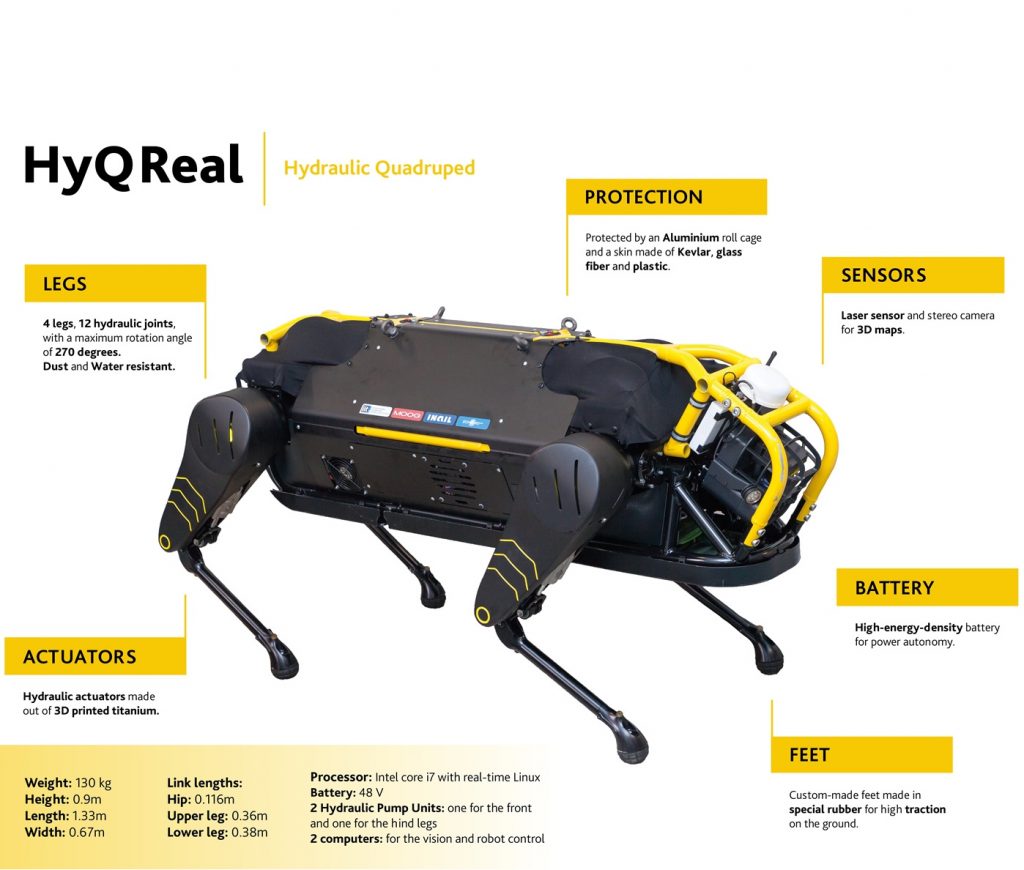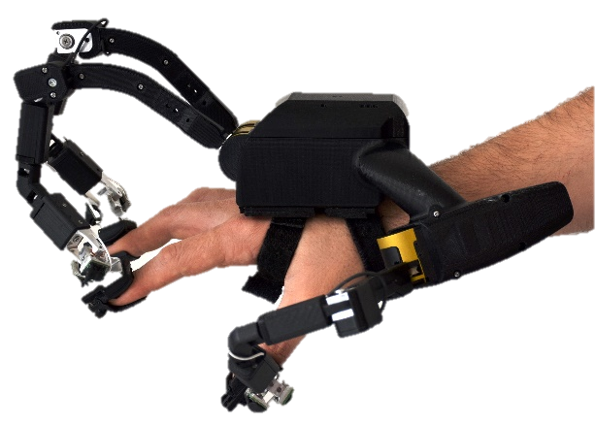
Robohub.org
The new IIT’s “Robot Teleoperativo” (teleoperation robot)
The Robot Teleoperativo is a new robotics result achieved at IIT-Istituto Italiano di Tecnologia and combining the rugged locomotion of HyQReal robot with dexterous and powerful manipulation assured by a new robotic arm, controlled by immersive VR visualization and haptic teleoperation. It represents a significant contribution to the state-of-the-art robotics dedicated to intervention on unstructured, difficult terrain environments, requiring powerful capabilities. The human operator can always be in control, not being replaced by the robot but substituted and assisted by it, in the case of situations where humans may be exposed to risks for their health, such as disaster response or emergency in nuclear, marine, chemical, oil-&-gas, environments.
In a new video, researchers show the achieved results: the Robot Teleoperativo is able to open doors, access fire equipment, gather precious items, navigate in the dark, and walk over difficult terrain. The video was showed during the international conference ICRA 2021, on May 31st.
With the effective execution of such tasks, albeit in simulated lab setup scenarios, the three years of developmental research in the Robot Teleoperativo project has shown that although the challenge of substituting human workers is a difficult one, it is certainly not an insurmountable one.
The project is a result of the close collaboration between IIT-Istituto Italiano di Tecnologia and INAIL (Italian National Worker’s Compensation Authority). The 3-year project started in 2017 with an aim to enhance occupational safety and health (OSH) in demanding and dangerous occupations. The goal was to keep the worker who is engaged in high-risk interventions in demanding environments, at the core of the development; researchers worked with firefighters to define specific needs and they will further explore the use of Robot Teleoperativo in realistic scenario.
Robot Teleoperativo consists of two modules, the field robot and the pilot station. The field robot integrates the versatile locomotion of the HyQReal hydraulic quadruped robot with the dexterity and power of the INAIL-IIT multi-degrees-of-freedom (DOFs) robotic arm. At the pilot station, the 6-DOF haptic teleoperation device REMOTArm, including the 3-finger HEXOTrAc-Plus hand exoskeleton, combines with the 3D virtual reality (VR) based intuitive, information-rich interface for perception, interaction, and teleoperation. The field-pilot combination offers an immersive telepresence experience to the operator (worker), allowing them to project their actions to and perceive the information from the remote environment through the field robot.

The HyQReal quadruped, with its 90 cm height, 133 cm length, and 130 kilograms of weight, demonstrated in 2019 being able to develop sufficient force to tow a passenger plane of over three tons. With its advanced locomotion, the HyQReal is capable of navigating difficult terrain, characterized by slopes, stairs, or debris, with a degree of mobility far greater than in the case of wheeled or tracked vehicles. The HyQReal is equipped with a variety of cameras and multimodal sensors for real-time environment perception.
INAIL-IIT arm is a robotic manipulator with strength and dexterity. The 5-DOF serial robotic arm provides the ability to interact with, and manipulate the environment with robustness, precision, and power. It is about 1.0m in length, and has a 4 kg payload capacity. Its 5 joints integrate compact and lightweight, torque controlled actuators, which allow the manipulator arm to operate in position and / or torque-control depending on the task. The HERI II robotic hand, with its multi-finger configuration, combines strength and dexterity for grasping heavy as well as delicate objects.

REMOTArm is the haptic teleoperation pilot interface for precise tele-manipulation. The REMOTArm is a desk-mounted, 6-DOF, haptic teleoperation device. It tracks the position and orientation of the operator’s wrist with high accuracy, and offers a much larger workspace than similar commercial devices. It provides 3-DOF force feedback at the wrist (> 20N). The 3-finger HEXOTrAc-Plus hand exoskeleton is an ergonomic haptic glove that accurately tracks the operator’s gestures when tele-manipulating the field manipulator. Its actuators can display the remotely sensed interaction forces (< 10 N) to the user at the robotic hand as they happen. The interface is lightweight, easy-to-wear, and includes gravity compensation for user comfort.
The operator uses a VR system for an immersive 3D perception of the remote environment. The user interface, using commercial head-mount display devices and VR software, makes for an intuitive and effective real-time projection of the field of action for the remote operator. Using the multimodal vision, depth, and ambient sensing system on-board the field robot, the interface “reconstructs” the remote field context for the operator, providing an information-rich interface for perception, interaction, and control.
This successful outcome has encouraged researchers to push the boundaries of technological innovation further. IIT and INAIL continue their close collaboration in this field aiming at expanding the possibilities in remote telerobotics research and its transition from the lab to the real hazardous work environments.
Further information
The research study was coordinated by Nikhil Deshpande, Researcher at IIT’s Advanced Robotics Line, and involved the research groups led by Claudio Semini (for HyQReal), Nikolaos Tsagarakis (for manipulation) and Ioannis Sarakoglou (for teleoperation) at IIT in Genova (Italy).
Website: https://advr.iit.it/projects/inail-scc/teleoperazione
tags: c-Research-Innovation



